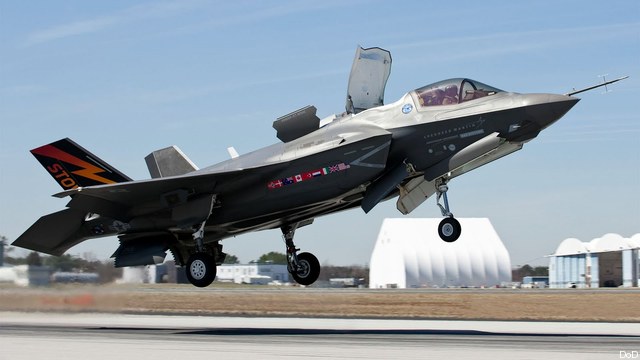WASHINGTON: Will the F-35B land vertically at the Royal International Air Tattoo or the Farnborough Air Show? No. Will it hover? Yes.
One of my colleagues had raised the issue that the F-35B will not perform a vertical landing this July, inferring this might be because it would damage the plane or the runway.
F-35 program spokesman Joe DellaVedova told me that the Marine version of the Joint Strike Fighter will perform short takeoffs and landings and perform hovers at both shows. I’m betting you can expect the same at the July 4 christening of the HMS Queen Elizabeth.
The blast from an F-35B as it lands vertically is pretty fearsome, but the Marines, Navy and program office all say the effects are manageable. I’ve seen the landing spots on the USS Wasp after several days of F-35 testing and spoken unsupervised with crew members. The Wasp deck crew told me they were seeing less damage to the deck than it sustains from some other aircraft that routinely fly from the Wasp and other LHD class ships.
The Wasp desk was coated with Thermion, a new product composed of aluminum and ceramic that are bonded together by heat at application to form a very smooth and tough heat-resistant coating. By contrast, the runways at Farnborough are designed to handle general aviation jets and airplanes. Nothing larger than a 737-800 is permitted to land except during the air show. The RIAT runways are designed for Royal Air Force and American jet aircraft, including B-52s. Fairford is a standby air base, not one used regularly except for the annual air show. A source familiar with the plane’s testing tells me the aircraft could easily and safely perform several vertical landings on an up-to-date military grade runway.
So, the question remains, why not land vertically at the shows? “We want to showcase how we will operate this plane during combat operations,” Capt. Richard Ulsh, a spokesman for the Marine deputy commandant for aviation, told me today. During a combat operation or for expeditionary use the plane would perform rolling or short takeoffs and landings on land to conserve fuel, Ulsh said. The plane is undergoing testing for landings on concrete and grass and dirt. The tests for concrete are finished, Ulsh said, but those for grass and dirt takeoffs and landings are not complete. Organizers made available a dirt and grass area at Farnborough. The F-35B has performed more than 450 vertical landings, Ulsh said.
He added that vertical landings consume a great deal of fuel and claimed the Marines made their decision in part because they are “trying to be good stewards of taxpayer dollars.”
In a ‘world first,’ DARPA project demonstrates AI dogfighting in real jet
“The potential for machine learning in aviation, whether military or civil, is enormous,” said Air Force Col. James Valpiani. “And these fundamental questions of how do we do it, how do we do it safely, how do we train them, are the questions that we are trying to get after.”




























